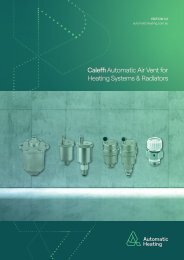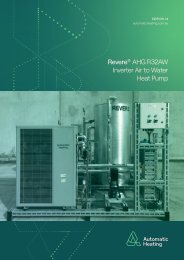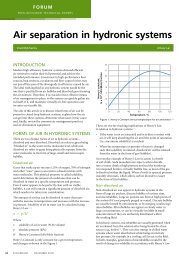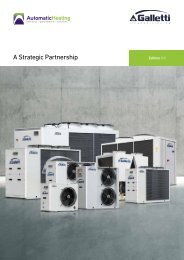AHG Solutions Guide_Edition 2.7
Full Product and Solutions Guide - Automatic Heating Global Pty Ltd
Full Product and Solutions Guide - Automatic Heating Global Pty Ltd
Create successful ePaper yourself
Turn your PDF publications into a flip-book with our unique Google optimized e-Paper software.
Contents<br />
Expansion Tanks & Pressurisation Systems<br />
Calculating Expansion Tank<br />
Pre-charge Pressure<br />
Please use the below calculation to correctly determine<br />
the expansion tank pre-charge pressure:<br />
Pi = [Hm x 10] + 20kPa<br />
where:<br />
Pi = Initial charge pressure (absolute) of vessel<br />
Hm =<br />
System height (metres) above the location of the<br />
expansion tank<br />
Installation<br />
1. The expansion tank must be installed on the suction<br />
side the system pump and preferably in the coolest<br />
part of the system e.g. on return to boiler.<br />
2. Ensure water entering the tank is less than 70ºC,<br />
to prevent premature diaphragm failure. If water<br />
temperature is higher than 70ºC, an intermediate tank<br />
must be installed between the expansion tank and the<br />
system.<br />
3. The expansion tank must be installed with a lockable<br />
service valve and drain point. This is to ensure the tank<br />
can be serviced properly in the future.<br />
4. The expansion tank must be installed with a pressure<br />
relief valve between the tank and the lockable service<br />
valve, to protect the tank from overpressure situations.<br />
5. The pressure relief valve rating must be no higher than<br />
the safe working pressure of the expansion tank.<br />
Commissioning<br />
Please follow the below 4 step process for commissioning<br />
an expansion tank:<br />
1. Disconnect<br />
a. Isolate the expansion tank from the system via the<br />
lockable service valve. This is crucial to ensure an<br />
accurate pressure reading.<br />
b. Disconnect from the system and drain the tank.<br />
2. Test<br />
a. Calculate the correct expansion tank<br />
pre-charge pressure.<br />
b. Test the pre-charge pressure in the expansion tank<br />
via the Schrader valve.<br />
3. Charge<br />
a. Charge the expansion tank to the correct (see note<br />
on calculating pre-charge pressure) pressure via the<br />
Schrader valve, using an air compressor or nitrogen<br />
canister.<br />
b. Recheck tank charge to ensure pre-charge pressure<br />
is holding. If a leak is found, the Schrader valve or<br />
the expansion tank will need replacing.<br />
4. Reconnect<br />
a. Reconnect the expansion tank to the system.<br />
b. Re-pressurise the system and check for leaks.<br />
Maintenance<br />
Please follow the below 5 step process for maintaining an<br />
expansion tank:<br />
1. Inspect<br />
a. Perform a visual check of expansion tank to ensure<br />
no obvious damage or corrosion is present.<br />
b. To check the integrity of the diaphragm, press<br />
down the Schrader valve. If water exits the valve,<br />
the diaphragm has ruptured and the expansion tank<br />
will need replacing.<br />
2. Disconnect<br />
a. Isolate the expansion tank from the system via the<br />
lockable service valve. This is crucial to ensure an<br />
accurate pressure reading.<br />
b. Disconnect from the system and drain the tank.<br />
3. Test<br />
a. Calculate the correct expansion tank<br />
(see note on calculating pre-charge pressure)<br />
b. Test the pre-charge pressure in the expansion tank<br />
via the Schrader valve.<br />
4. Charge<br />
a. Charge the expansion tank to the correct precharge<br />
pressure via the Schrader valve, using an air<br />
compressor or nitrogen canister.<br />
b. Recheck tank charge to ensure pressure is holding.<br />
If a leak is found, the Schrader valve or the<br />
expansion tank will need replacing.<br />
5. Reconnect<br />
a. Reconnect the expansion tank to the system.<br />
b. Re-pressurise the system and check for leaks.<br />
EXPANSION &<br />
DEAERATION<br />
169

















